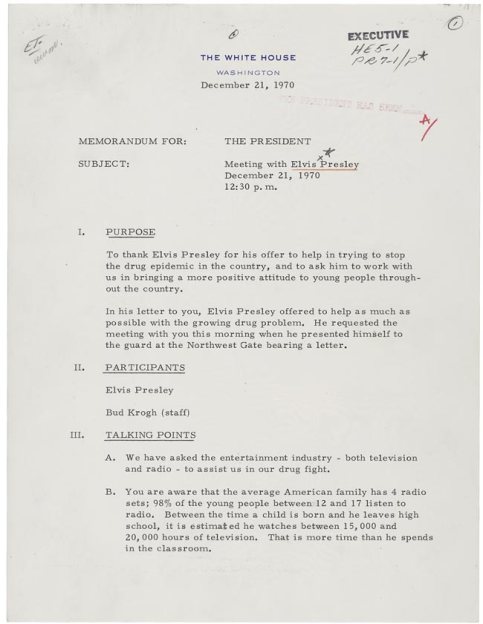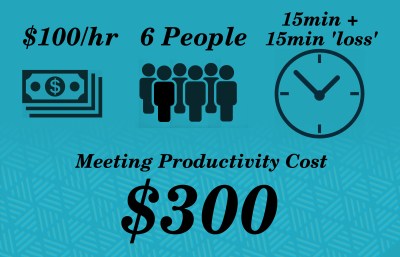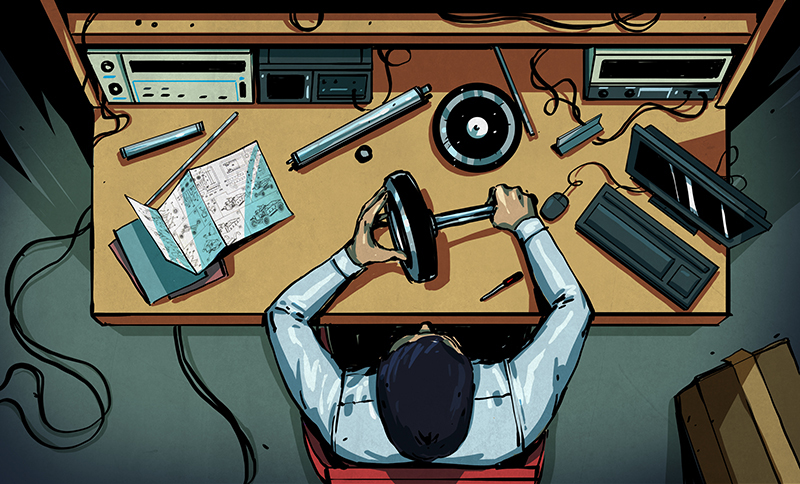Meetings can actually be useful. It’s hard to believe, but they can actually save time if done right. While most of us are in a perpetual state of torture by Kevin in marketing holding another three-hour meeting during lunch hours, there are a few of us who know their hidden power when put in the right hands.
Working as a contractor, wasted meetings mean wasted billable hours. Even wasted meeting time is covered in the cost of the contract it runs the risk of giving the client the impression that you’re not as productive as originally thought. Organized, productive meetings show that you know what you’re doing and that the cost of your services as a whole is a good value. Yeah, some meetings suck but they are necessary and should be productive.
A meeting needs three things to be worth the time spent on it.
- A well prepared for, simple, and clear agenda.
- A time limit.
- Something needs to be written down at the end of it.
I’ll start with the third item as it shapes the rest. The point of a meeting is to have something to write down at the end of the meeting. Any meeting that ends up in anything requiring fallible human memory was a waste of everyone’s time. This includes, verbal agreements, handshake agreements, ideating (pronounced idioting), brainstorming, think tanking, and the like.
Begin with a Clear Agenda
Productive meetings need a clear agenda. What is the meeting for?
- Can you cut out parts of it and have a shorter meeting?
- Are you making a group decision? What is that decision?
- Do you need to assign tasks? Write down the tasks you need to assign.
- Do you need to inform people of a development? Can you do it through email instead of a meeting?
- If not, as the person calling the meeting, it is your job to have all the materials ready in packets, have a well written summary of the material, and be ready to answer questions in a timely fashion.
- Do you need to “brainstorm”? If absolutely necessary, have a small meeting describing the problem, otherwise have people prepare ideas before the meeting. Then pick a direction using the meeting.

When the meeting is over everyone should get an email with all the asked questions, all the decisions, and what they should actually do with the information.
The nice part about having a clear agenda is that you can stop distraction. If you don’t have a clear agenda every small deviating discussion may appear to have worth. However, if your meeting has a goal at the end then it’s easy to say, “Hey, we’re getting distracted, can we have this discussion later, we are trying to reach a decision about X.”
For example, let’s say a client called your office and sent in the specifications of the black box they’d like ordered. Rather than tear through five hours sketching at the white board, arguing, and generally depleting brain sugar until everyone is cranky, the goal might be to quickly boil down the possible solutions to a paper list and then assign everyone clear tasks. In fact, the meeting could even be split into two. The first meeting can be fifteen minutes quickly reviewing the specs, giving people information packets, and followed by assigning the task of everyone brainstorming the most likely solutions. Then a second fifteen minute meeting in which each person’s top two ideas is written on the board, cross checked, and then assigned to people to evaluate separately.
The point is to leave with action items for each person in the group.
I am of the philosophy that any day that has more than an hour of meetings is poorly spent. If a meeting is running over forty-five minutes, it’s likely to be a total waste of time. It was probably set-up because the person doing it is stalling at a task and is hoping that either someone will solve it for them or they’ll be able to delegate it away by committee. Either that or it needs to be smaller meetings with separate distinct goals for each one.
Some of the best meetings I’ve ever been in were introduced with a time limit. The guy would wait until the room was full, look at his watch, and say, “it is now X time, in 45 minutes, or X+45, this meeting will be done.” After which he would read off his agenda, what he’d like to accomplish, and get started. After the meeting everyone would get an email describing the meeting, listing the decisions made, and explaining the tasks assigned to them. There were rarely repeat meetings.
Being the Meeting-Runner
What is your duty as the person running a meeting?
- Introduce the meeting. Why is everyone here.
- Introduce people if required.
- Also, unless you have no clue who someone is, having everyone go in a circle to introduce themselves is pure torture. You should know what everyone does as part of your research, give their name, introduce them quickly, and make sure all that information is in the follow up email (because only Starfleet androids can remember eight names and titles all at once). It should take no more than five minutes unless you’re some kind of sadist.
- Keep time. Make sure the meeting doesn’t run over.
- Keep the conversation on task. If people are getting distracted it is your job to steer them back. Even if it’s the CEO of a mega-corp, it’s okay to tell them to get back to the top.
- Keep notes, or assign someone to take notes. Collect, condense, and transcribe those notes after.
- Turn those notes into correspondence. If it’s not written down and someone else doesn’t have a copy to reference it didn’t happen.
- End the meeting. If the meeting is going on too long. Call it. It probably needs to be two meetings.
To split or not to split a meeting? It’s kind of a tough call. Meetings have their place, but even if the meeting only took fifteen minutes. It’s likely to eat fifteen minutes of time in everyone’s schedule on top of the length of the meeting and at least an hour of yours if prepared for and finished off properly. The kind of meetings that actually need to be long are few. Many meetings don’t even need to be held at all with proper correspondence between team members. Meetings are a double edged sword. They’re the greatest argument in favor of a traditional office and also its greatest annoyance.
 The real trick is to develop a skill for evaluating the return. If everyone’s time is billed at a hundred dollars an hour. If you have a fifteen-minute meeting with six people, then you’ve spent three hundred dollars’ worth of time: ((15 minute meeting + 15 minute interruption)/60)*100 * 6). You better have saved more than three hours of working time for your client with the meeting. If you ended up wasting it then the meeting was no good.
The real trick is to develop a skill for evaluating the return. If everyone’s time is billed at a hundred dollars an hour. If you have a fifteen-minute meeting with six people, then you’ve spent three hundred dollars’ worth of time: ((15 minute meeting + 15 minute interruption)/60)*100 * 6). You better have saved more than three hours of working time for your client with the meeting. If you ended up wasting it then the meeting was no good.
For example, I had a company that had thirteen separate meetings over an upgrade to their equipment that would have cost a total of three thousand dollars including labor. I once counted the time spent in one of the meetings, which included seven people, some who weren’t even in decision loop. It cost the company four thousand dollars in time. Amazing. If I were to have that same meeting over now I would have pointed that out immediately. Regardless, this eventually became the shining example in my mind of why I should quit and I don’t work there anymore.
Lay it on Us, Lumbergh
In conclusion. In today’s world of instant communication and email threads it is much easier to distribute information to people working in a team — one of the main goals of having general meetings. However a well laid out meeting is still devastatingly effective. It is a thing that should be carefully prepared for and not doing so is deeply disrespectful of the time of all involved. I’m sure many of you have suffered design meetings, planning meetings, planning for the planning meetings, and the like. Let’s have your thoughts on them below.
















1.) Be prepared that your client will or can’t deliver the information that you need to do the job.
2.) If your client is not interested in talking about costs it’s a red flag.
3.) ASAP is a red flag for procrastinators. This means the project is behind schedule and you’re starting a job behind the 8 ball.
4.) Red flag if you’re talking over someone else work. Why did the stop working on it?
5.) Don’t agree the job is easy because parts of it already done. It’s harder to reveres engineer someone else’s work then start over and you should get paid for it.
Don’t hide failures, share them.
1) Own your project failures.
2) Discuss what the failure is.
3) Seek help from others in fixing the failure.
4) If the failure gets fixed, then share how it got fixed and thank those who helped you.
This is ripe for a “time measured in dollars” clock, large display, sitting at the front, enter number of people and it counts… with splits maybe so you can tap a button and see how much a diversion cost.
Though spending several thousand meeting dollars on a few thousand dollar piece of equipment mayyy be appropriate in certain circumstances… such as every hour it’s offline costs you several thousand dollars, and 10% inefficiency in operation or user unfriendlyness over a month racks up to thousands.
+1
I like this idea, but I think the whole idea of “opportunity cost” might be slightly flawed. I can’t tell you how many times a short walk and a cup of tea has cleared up a problem for me. Slamming my head into a wall repeatedly wasn’t going to solve the problem faster. Also, nobody is 100% productive throughout the day.
Absolutely. The idea that a meeting costs X depending on the number of people and their rate card is a fallacy. It assumes that if you were not in the meeting that you would be 100% dedicated to a money making task. This may be more accurate in a retail outlet of some kind but it’s never been true of any office / professional environment I’ve seen.
The point of the clock should not be that, whatever amount is listed on the clock is wasted. It should be that, at the end of the meeting, everybody can look at it and ask the question, did we just give our clients $xx worth of work? The answer to that goes back into the feedback loop to make the next meeting more efficient. I’m rarely of the opinion that efficiency–particularly measurable, obvious-to-a-third-party efficiency–is the highest good, because my work involves a lot of thinking, where you do need to get up, stretch, think about something else, go home and sleep, and all kinds of other stuff in between starting the problem and solving it. However, meetings don’t provide any of that, and they’re generally distracting and painful for the people involved unless they’re well-run.
I agree. One project I was on was crippled by a failure of a purchased component. Instead of going the supplier, the management wanted daily progress meetings on what I was doing to fix the problem. Rules I had to work with:
1) Fix it.
2) Do not touch or disassemble any failed units
3) Continue testing to demonstrate they were still failing.
The next higher persons were 2 levels of management up from me. And their bosses. I figured it cost about $1000 each morning to get the 8 of them into that meeting. I told them (lied) that testing was taking more effort and could the meetings be alternate days? That saved $10k before some one of them finally realized that since I wasn’t going to be able to see what the problem was without X-Ray vision (and no, x-rays would not have helped) that calling the supplier and asking them might do the trick. Duh. Supplier was ignorant, not stupid.
Having that clock ticking off the amount those mooks wasted would have been priceless. Had a second one been available that counted costs for the delay of project …
I didn’t even get the 10% finders fee that should have been awarded for finding that amount of lost cash.
And this is why I-O Psychologists and Industrial Engineers are always fighting.
List the project deliverables and ask each responsible party that has authority over the deliverable if it is “on track or not”. At the end of the list, gather more information on each deliverable that has stagnated. Other members of the team are then solicited for feedback on how to correct that deliverable.
A decision is then made by the principles on which feedback should apply or if external help is needed. Project progresses. Ad infinitum
I thought the ad infinitum was what we were trying to avoid ;-)
Not in the case of meetings. They will always need to occur.
I’m amazed that in the 70’s Elvis could walk up to the White House and meet with the president.
Reads more like he was summoned to me.
There is a good short book called “Please read this before our next meeting.” He has some of the same advice, but also frowns on meetings that are just to provide status. Meeting should make decisions or gather information to support making a decision. I usually make my new guys read this to get an idea about how I feel about meetings: https://www.linkedin.com/pulse/20140515053145-10912459-seven-questions-to-ask-before-calling-a-meeting
One other thought. I have found that a very effective technique–especially when using a WebEx or other virtual meeting–is to open up a drawing or a document. It can be blank (in fact, that’s usually best) or it can be some straw man. And make the meeting about making that drawing or document correct. People actually engage, they get ownership, and at the end of the meeting if you do it right you have a real work product that means something.
Very good article. AC approves of that message.
Um, I normally think all those ‘not a hack’ posts are annoying but this seems pretty far from the topic of hacking.
Well you could kinda sorta nearly stretch it to fit “How to hack corporate bureaucracy so you can get real shit done.”
I’m just going to leave this here because this article made me think of it.
https://youtu.be/BKorP55Aqvg
Yup, that’s exactly what meetings are about, every single one of them. They’re nothing but ego wrestling matches to decide who will land the impossible task or take the blame for failing to carry it out. The subject at hand is irrelevant and has nothing to do with any of it, nor what any participant has done or will do before / after – all that matters is how apt each participant is at deflecting responsibility and blame at someone else (clue: no, it won’t be the management, unless you somehow failed to fail and credit needs to be misappropriated). Utter waste of time, the lot.
… That point in your life when you have a sudden revelation that you’re trapped in a Dilbert comic…